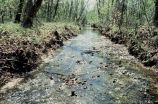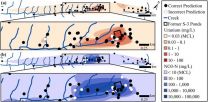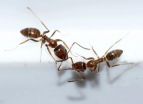(Press-News.org) First there were canaries in coal mines, now there are microbes at nuclear waste sites, oil spills and other contaminated environments. A multi-institutional team of more than 30 scientists has found that statistical analysis of DNA from natural microbial communities can be used to accurately identify environmental contaminants and serve as quantitative geochemical biosensors. This study was sponsored by ENIGMA, a U.S. Department of Energy (DOE) Office of Science "Scientific Focus Area Program" based at the Lawrence Berkeley National Laboratory (Berkeley Lab).
"Changes induced in the natural microbial community structure by contaminants lasts long after the contaminants themselves have become undetectable," says Terry Hazen, an internationally recognized authority on microbial ecology who led the research.
"This means the DNA of these microbial communities can be used as a forensic tool for measuring anthropogenic effects on the environment."
Hazen, who holds joint appointments with DOE's Oak Ridge National Laboratory (ORNL) and the University of Tennessee at Knoxville, is the corresponding author of a paper detailing the results of this ENIGMA study in mBio, the online open-access journal of the American Society for Microbiology. The paper is titled "Natural Bacterial Communities Serve as Quantitative Geochemical Biosensors." For a complete list of authors go here.
For this study, the ENIGMA collaborators identified the most independent and interesting groundwater well clusters from 25 years of monitoring data collected at the Bear Creek watershed in Oak Ridge. This watershed was a crucial site for the early development of nuclear weapons under the Manhattan Project and harbors spectacular geochemical gradients. The collaborators
then collected a large number of microbial DNA samples from the identified wells in combination with 28 other physical/chemical characteristics.
"The wells we sampled typically contain a high number of particulates in the groundwater, thus causing the filters we collected DNA on to clog easily," says Andrea Rocha, a post-doctoral associate in Hazen's research group, who spent three months collecting samples from the watershed. "We had to change our filters each time they clogged until we obtained our required four liters of groundwater. Sometimes this meant changing filters five to six times for one well."
Analysis of the DNA data from the collected groundwater samples was carried out via a technique called "supervised machine-learning," which the ENIGMA team applied to high-throughput DNA sequencing data.
"Because microbial communities continuously sense and respond to their environments, they form a ubiquitous environmental surveillance network that can be inexpensively digitized through DNA sequencing," Hazen says. "Our idea was to determine whether and how information encoded in bacterial communities might be tapped to quantitatively characterize the environment."
While previous research demonstrated that specific proteins or
whole bacterial cells could be used as biosensors to translate environmental signals into machine-readable data, the focus of the ENIGMA study was on the integration of information gathered from native bacterial communities containing billions of cells and encompassing thousands of taxonomic groups.
With just the sequencing data from the 16S rRNA gene alone, the ENIGMA team was able to quantitatively produce "a rich catalogue of 26 geochemical features" from 93 groundwater wells with highly differing geochemistry characteristics. These features were then used to predict contamination. The accuracy for predicting uranium contamination of the groundwater was about 88-percent, and the accuracy for predicting nitrate contamination was about 73-percent.
"Our work shows that knowing what bacteria are present allows us to infer something about the current or past chemistry of a site," says Eric Alm, an MIT microbiologist and one of the principal investigators on this project. "The next big challenge will be to understand why different bacteria are associated with different environmental conditions."
As human populations continue to grow and the industrialization of developing nations continues to expand, the impact of human activity on the environment is only going to intensify. Measuring the causes and consequences of these impacts is a challenge that science must meet. The ENIGMA project demonstrates one path towards meeting this objective.
"It takes an integrated team to tackle a large problem like this," says Paul Adams, the SFA Laboratory Research Manager for ENIGMA. "The work with these natural microbial communities highlights what can be achieved through interdisciplinary research that harnesses ENIGMA's scientific expertise in field sampling, high throughput sequencing, and computational analysis."
INFORMATION:
Lawrence Berkeley National Laboratory addresses the world's most urgent scientific challenges by advancing sustainable energy, protecting human health, creating new materials, and revealing the origin and fate of the universe. Founded in 1931, Berkeley Lab's scientific expertise has been recognized with 13 Nobel prizes. The University of California manages Berkeley Lab for the U.S. Department of Energy's Office of Science. For more, visit http://www.lbl.gov.
DOE's Office of Science is the single largest supporter of basic research in the physical sciences in the United States, and is working to address some of the most pressing challenges of our time. For more information, please visit the Office of Science website at science.energy.gov/.
Researchers at Case Western Reserve University combined finely crafted nanoparticles with one of nature's potent disrupters to prevent the spread of triple-negative breast cancer in mouse models.
The highly aggressive cancer subtype is difficult to manage and, currently, the FDA has no approved targeted treatments. But striking results from a new study, published in the journal Cancer Research make the researchers optimistic they have a potential game-changer for triple negative cancer and more.
"There are multiple targets within a cell," said William Schiemann, professor ...
Pregnant women who exercise can significantly lower the risk of undergoing Caesarean sections and giving birth to large babies, a University of Alberta study has found.
Prenatal exercise has been suggested to be a means to prevent childhood obesity through a "normalization" in birth weight (ie. reducing the risk of having a large baby at birth). University of Alberta researchers conducted a meta-analysis to analyze 28 randomized control studies encompassing 5,322 women that looked at the influence of maternal exercise on baby outcomes.
"We found that women who exercised ...
In a study that compared three sites within the Dja Conservation Complex in Cameroon, Africa, investigators found that the presence of a conservation research project acts as a deterrent to chimpanzee and gorilla poachers, and community awareness and involvement in research lead to an increased value of apes and intact forests to local people, thus limiting hunting practices.
The results provide evidence that the mere existence of research programs exerts a positive impact on the conservation of wildlife in their natural habitats.
"It's important to recognize the effectiveness ...
Mass shootings at the hands of unhinged loners - such as those in Aurora, Colorado; Santa Barbara, California, and Newtown, Connecticut - perpetuate a commonly held belief that mental illness triggers violent crimes.
But a new study from the University of California, Berkeley, shows that hallucinations and delusions associated with psychiatric disorders seldom foreshadow acts of aggression.
In a painstaking review of 305 violent incidents in the United States, the researchers found that only 12 percent were preceded by psychosis. While numerous studies have found that ...
When ants go exploring in search of food they end up choosing collective routes that fit statistical distributions of probability. This has been demonstrated by a team of mathematicians after analysing the trails of a species of Argentine ant. Studies like this could be applied to coordinate the movement of micro-robots in cleaning contaminated areas for example.
Scientists have yet to discover the mechanisms explaining how flocks of birds, shoals of fish, lines of ants and other complex natural systems organise themselves so well when moving collectively.
To tackle ...
Scientists at a U.S. Army research center have modified an assay that tests whether or not a sample of mosquitoes harbors the virus responsible for the disease known as chikungunya (CHIKV), long a problem in the Old World tropics but recently established in the Americas. Their assay is described in an article in the Journal of Medical Entomology.
Health workers now have a quick way to detect the presence of the CHIKV virus within an hour, rather than waiting for results of laboratory tests that take days, or even weeks. It's done with a chemical dipstick, the same kind ...
KNOXVILLE--The reaction most people have when they hear the word bacteria is rarely a good one.
While it's true that food- and water-borne bacteria cause untold illnesses and even death around the world, a team of researchers from the University of Tennessee, Knoxville, and Oak Ridge National Laboratory has found a way to use bacteria to help prevent some of the very symptoms most people associate with them.
Terry Hazen, the Governor's Chair for Environmental Biotechnology, a joint UT-ORNL appointment, is working with a team of researchers who have developed a method ...
MAYWOOD, IL - Among the deadliest cancers is a rare malignancy called mesenchymal chondrosarcoma, which begins in cartilage around bones and typically strikes young adults.
Ten-year survival has been reported to be as low as 20 percent. But a Loyola University Medical Center study has found survival is not as dismal as prior reports. Among 205 cases examined, more than half (51 percent) of patients survived at least five years, and 43 percent survived at least 10 years, the study found.
The study by senior author Lukas Nystrom, MD, and colleagues was reported at the Mid-America ...
May 12, 2015 - It's portrayed in movies again and again - a character gets rejected by someone attractive and then falls willingly into the arms of someone perhaps less attractive. According to a new study, it's not so simple: Rejection by an attractive man actually led women to socially distance themselves from an unattractive man, even when he offered acceptance.
"We hadn't expected to see derogation of the unattractive male when women had been rejected by the attractive male," says Geoff MacDonald of the University of Toronto and lead author of the new study in Social ...
COLUMBIA, Mo. - Down syndrome, the most common chromosomal disorder in America, can be complicated by significant deterioration in movement, speech and functioning in some adolescents and young adults. Physicians previously attributed this regression to depression or early-onset Alzheimer's, and it has not responded to treatments. Now, a researcher at the University of Missouri has found that Catatonia, a treatable disorder, may cause regression in patients with Down syndrome. Individuals with regressive Down syndrome who were treated for Catatonia showed improvement, the ...



